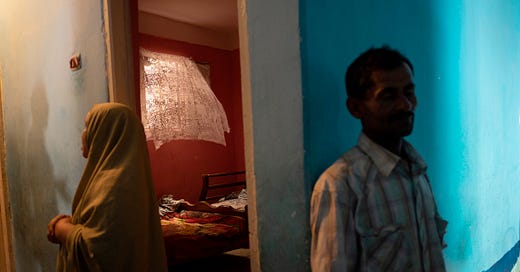There’s a shadowy figure, on the leftmost side of the picture, to whom the woman has likely turned. Such is the subtlety in this picture, an imagining of things seen from multiple angles, including a man depicted in a corner of the house, between rooms. With his pursed lips and angular cheekbones, his person elicits an instant pathos, even if nothing is known of him. Two bed frames are visible from within the open room, as well as a curtain, billowed inwards by a passing surge of wind, and bringing with it the knowledge of a world beyond a cloistered house.
— Emmanuel Iduma
“If the story is from the heart, I believe it will reach the heart.”
This photograph was taken in Al Max Neighborhood, Alexandria, Egypt.
Ali is among the protagonists I met in 2016 when I started my project “Here, The Doors Don't Know Me.” They lost their houses by 2021.
Ali built the house with his wife as most of the fishermen did. The image reminds me of that feeling of waiting in your house for someone you don't know to take you out of the house and change your life forever.
The photograph is part of the project about the neighborhood of Al Max, a once-picturesque fishing community in Alexandria, Egypt, showing residents as they face the devastating news of their imminent displacement. Labeled "Little Venice" for its canal-side charm, their homes, and livelihoods are threatened by a government demolition plan. Years of uncertainty and a state-led media campaign have fueled resistance, but the demolitions continue.
Inspired by the plight of the Al Max residents, I embarked on a project to capture their stories, collaborate with the community, and preserve their memories through photographs and heartfelt letters. As the sea-faring community lose their homes, their shared narratives become a testament to their resilience and unity.
I choose to make long-term projects as I always ask myself, "Who am I to represent someone's life or struggles?" Even if it is a project in my neighborhood and community. And in the end, since everyone has different lives and struggles, do I feel deeply about what I am doing in order to photograph it? Am I honest and do I know enough about what's going on? All of these ethical questions to myself tell me I know nothing about life and even myself but encourage me to take steps in order to answer them. And usually, those steps take years; I need to live with people so I can share their struggles with them and frame it right. I need them to trust me so we can collaborate in narrating the story together. And all of that takes time.
So, if the story is from the heart, I always believe it will reach the heart. The process gets me close to the reality of the story and what I am talking about. Two of my long-term projects have made a huge impact on the society here which gives me a passion to keep working in the same approach.
— Mohamed Mahdy
About Mohamed Mahdy
Mohamed Mahdy (b. 1996) is an award-winning visual storyteller from Alexandria, Egypt, who uses multimedia as a narrative tool. His work concentrates on the hidden and often unseen communities in Egypt, tackling diverse cultural and social issues relevant to the context in which he works. In 2018, Mahdy was named by The New York Times Lens Blog as one of 12 emerging photographers to watch. In 2021, he was selected as a Photography and Social Justice Fellow of the Magnum Foundation, and in 2022, he was named by The Guardian as one of five emerging talents in photojournalism. He also won the 2022 Canon Student Development Program. Mahdy’s work has been exhibited worldwide. Recently, he won the World Press Photo Award 2023, at both regional and global levels, and he was shortlisted for the CAP Prize 2023. See more of his work: Website; Instagram.
Last Week — “A Symphony of Perfect and Fleeting Time” by Sehin Tewabe
This photograph is one of my personal favorites. It stands out due to its exceptional composition, perfect timing, and the remarkable way lighting and shadows framed my subjects.
SUPPORT TENDER PHOTO
This is the 75th edition of this publication, which also read on web (best for viewing images), and via the Substack iOS/Android apps.
Every Wednesday I feature one photograph and the photographer who took it: you’d read a short caption from me, and a statement from the photographer. Every Saturday, between June 3–July 29, I’m writing a series of micro-essays in response to sequences of photographs previously featured on the newsletter. My hope is to engage with early to mid-career African photographers, and to create a platform in which photographers lead the cataloguing and criticism of their work.
Photographers can now submit their work for consideration.
Thank you for reading. If this newsletter was shared with you, consider subscribing, or forward to a friend. Please whitelist the newsletter to ensure you never miss it.






touching and well done